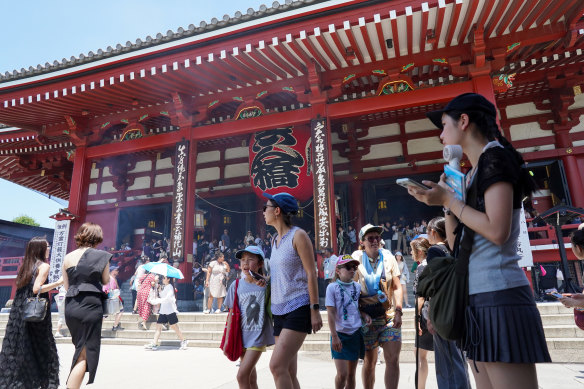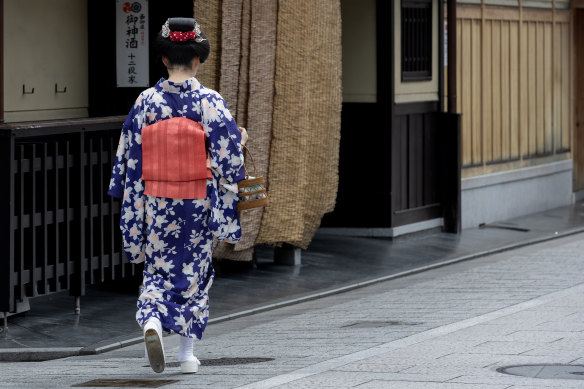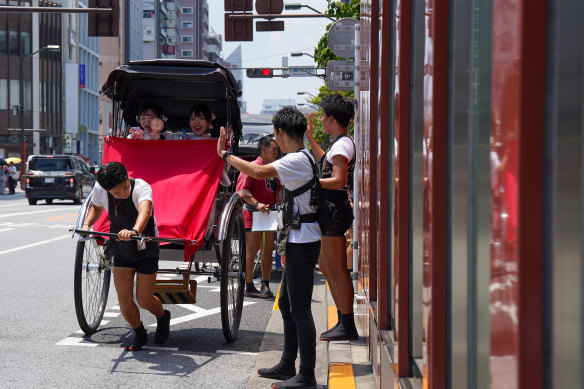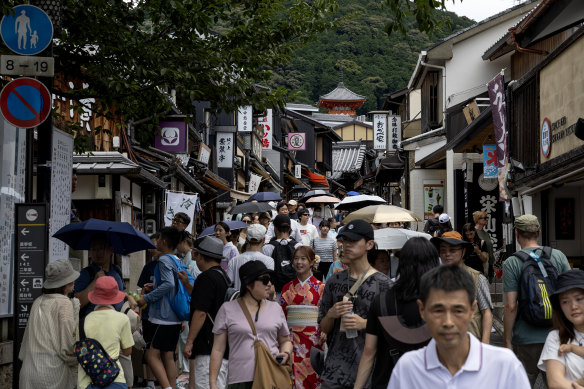By Lisa Visentin
It is mid-morning in Tokyo, and the mercury is approaching 36 degrees, but the summer heat has done little to deter the flood of tourists streaming towards the ancient Sensoji Temple from the train station in the city’s Asakusa district.
Travellers shimmy past each other along the Nakamise-dori shopping street, the main thoroughfare to the temple, sometimes pausing to wipe sweaty brows, or to cast their gaze through the crowd searching for companions lost in the stalls selling trinkets and Japanese paper fans.

Hotter than July: Soaring temperatures have not deterred crowds from Tokyo’s famous Sensoji Temple.Credit: Christopher Jue
The steps to the temple’s entrance are lined with people, some in hired kimonos, posing for the perfect Instagram shot. A few, defeated by the sun, have parked themselves on the higher steps in the shade of the pagoda, forcing the hordes to divert around them.
The 7th-century Buddhist temple has long been a drawcard for tourists to Japan, but this year, the shrine – along with other popular attractions across the country in places like Kyoto – has heaved under the weight of record numbers of visitors, many of them clamouring to take advantage of a historically low Japanese yen.
But the boom is proving a double-edged sword – embraced by businesses and tourism industries reliant on cash-splashing visitors while challenging the patience of locals forced to grapple with crowded public transport, litter, inflated prices, and noise pollution, especially around sacred and environmentally delicate sites.
In some sightseeing hotspots, local authorities have imposed crowd control measures – such as caps and restrictions on visitors – and a growing number of businesses are experimenting with two-tiered pricing system designed to keep prices low for locals.

A Maiko, or apprentice Geisha, walks along the famous Gion district’s Hanamikoji Street lined with teahouses. Credit: The Sydney Morning Herald
For Queensland family Bec and Elliott Hall, who were navigating the crowds at Sensoji Temple with their 9-year-old daughter Sierra on a hot Monday in late July, the strength of the Australian dollar against the yen has made Tokyo an affordable holiday.
“The exchange rate is the best it’s ever been, so that was definitely a factor. But there were other factors, too, like the food,” says Bec.
“We were considering doing Bali, but we chose Japan instead.”
Many Australians have reached the same conclusion: that there has never been a better time to visit the land of the rising sun. Over the past six months, Tokyo has sometimes pipped Bali as the most searched-for tourist destination by Aussies on platforms like Booking.com.

Rickshaw driver Sora Suzuki, 24, sets on in a sprint around the streets of Tokyo’s Asakusa district. Business is “super busy”, he says. Credit: Christopher Jue
More than 462,000 Australians have visited Japan this year, a 70 per cent increase compared with the first six months of last year, but still just a small fraction of a much larger pie. In total, a record 17.7 million tourists arrived in Japan between January and June, up 66 per cent over the same period in 2023 and a 6.9 per cent increase from 2019, according to data released by the Japan National Tourism Organisation.
Most visitors hail from East Asia, namely South Korea, China, Taiwan and Hong Kong, followed by the United States.
For Sora Suzuki, a 24-year-old rickshaw driver, the tourism boom has quite literally run him off his feet. He ferries visitors around the streets of Asakusa, strapping them into a chariot-like cart and setting of at a cracking pace. He completes as many as 10 trips a day, the average 30-minute ride costing 10,000 yen ($102) for two people.
“It is super busy. Super, super busy, even on weekdays,” he says before breaking into a sprint to haul his latest cargo, two kimono-clad tourists from Asia.
Tokyo, a sprawling international city of 14 million, is better equipped than other areas to cope with a huge influx of tourists.
It is a different story at the pristine foothills of Mount Fuji, a UNESCO World Heritage site. For the first time, Japan has capped visitors to Mount Fuji at 4000 a day and set a 2000 yen ($20.40) access fee between July and September after unprecedented numbers of hikers trammelled the slopes during last year’s peak season, causing traffic jams and leaving garbage piles on the most popular trails.
In the nearby small town of Fujikawaguchiko, authorities erected a giant black mesh barrier in front of a Lawson convenience store that had the mixed fortune of magnificent views of the mountain. The lure of snapping the quintessential Japanese photo drew thousands of sightseers to the store after the image went viral on social media, frustrating locals who complained about smartphone-wielding tourists clogging roads and climbing onto roofs to get the perfect shot.
Within days, holes had been poked in the mesh, and last month, officials replaced it with a sturdier barrier.

The ascent of the masses: Visitors walk the sloping streets to the Kiyomizu-dera Temple.Credit: The Sydney Morning Herald
In Kyoto, a drawcard precisely for its window into ancient Japanese culture and traditions, mass tourism is jarring with the slower-paced lifestyles of locals. In June, the local government began running extra bus services around the city, including new sightseeing express buses to ferry tourists between main attractions.
“Some of the locals living near the touristy areas became very frustrated because there was not enough space on the buses. In some areas, there are zero Japanese people, only foreigners,” says a taxi driver in Kyoto, who declines to give his name.
Tensions are most strained in Kyoto’s Gion geisha district. Since April, tourists have been banned from entering the private roads and alleyways winding through the area – a final straw measure by the local council after repeated instances of women being chased and photographed without permission.
“We have a lot of Maiko and Geiko [geisha] passing by in front of the restaurant, so we see them being chased all the time,” says Yasuko Terashima, a worker at a Kaiseki restaurant in Gion.
On a Thursday afternoon, the famous Hanami-koji Street in the heart of the Geisha entertainment district is deserted, making it an easy commute for liquor delivery driver Nonaka Masahki as he restocks the teahouses lining both sides of the strip. The area comes alive from dusk, and it is then that Masahki feels as though he has been transported out of Japan.
“I feel like I’m working abroad,” he says. “About 80 per cent of the people I pass by are foreigners.”
Mostly, they are well-behaved, he says. But the signs erected along the street instructing visitors on “manners in the Gion-Machi South District” point to ongoing issues.
“Don’t touch lanterns, fences or doors on private houses. Don’t spread out and block the street,” the signs warn.
Just a few blocks away, at the base of the hill climb to the Kiyomizu-dera temple, the 25 tour buses banked in the parking lot are a harbinger of the hordes ahead as more buses roll in by the minute. It is low season in Kyoto, and yet, to traverse the 350-metre incline to the shrine is to be part of a relentless ascent of the masses.
For Rei Matsuo, 53, who runs a Kimono rental business and a restaurant in a quaint side street, business is booming. His shop rents about 20 kimonos a day (this doubles in peak season), and by lunchtime, his restaurant is full. He has lived his whole life in these ancient streets and can remember a time when the shopfronts were modest homes, and the tourists were mostly Japanese.
But he is not nostalgic.
“Business is good,” he says. “After the pandemic, nobody was here. They only began coming again last March.”
Around the corner, his neighbours are less content. Pinned to their wooden fence is a hand-drawn sign: “Don’t throw away your cigarettes, foreigner!!”
With the Japanese economy languishing under the double dilemma of a rapidly shrinking and ageing population, tourism is playing an increasingly important role in driving growth. Travellers spent a record 1.75 trillion yen ($18 billion) in the first quarter of the year, making it Japan’s second-largest export after cars, leapfrogging electronic components and steel.
Prime Minister Fumio Kishida has grand ambitions for his country’s tourism to soar to extraordinary heights, setting a goal of luring 60 million travellers by 2030 – almost double 2019’s record 31.9 million visitors.
For locals in sleepy towns who enjoy panoramic views of Mount Fuji or relish the full bloom of cherry blossom season, the great mesh barrier may well become a mainstay.
Get a note directly from our foreign correspondents on what’s making headlines around the world. Sign up for our weekly What in the World newsletter.